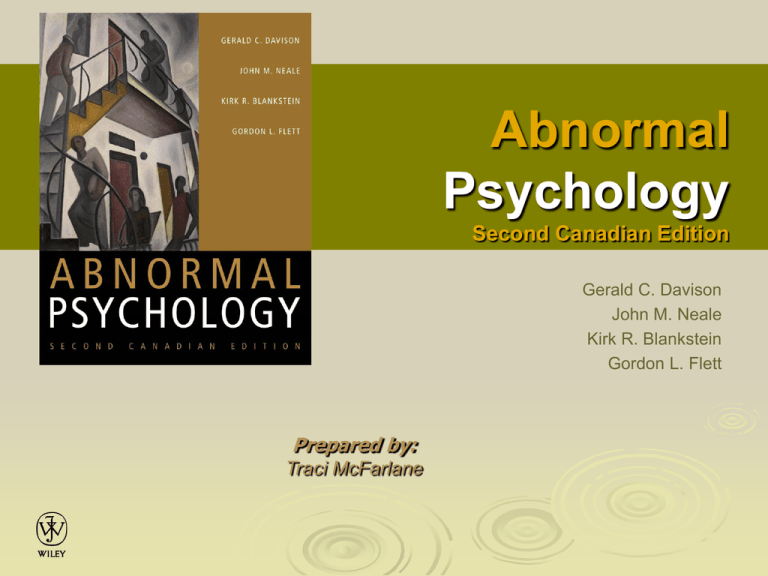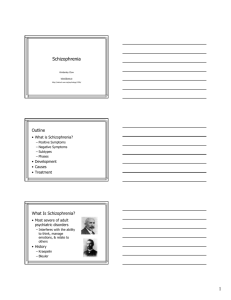
Abnormal
Psychology
Second Canadian Edition
Gerald C. Davison
John M. Neale
Kirk R. Blankstein
Gordon L. Flett
Prepared by:
Traci McFarlane
Chapter 11
Schizophrenia
Schizophrenia
• Schizophrenia
Psychotic disorder characterized by major
disturbances in thought, emotion, and
behaviour
Disordered thinking in which ideas are not
logically related, faulty perception and
attention, flat or inappropriate affect, and
bizarre disturbances in motor activity
Clinical Symptoms of Schizophrenia
• Positive symptoms
Excesses or distortions
Disorganized speech (thought disorder)
• Incoherence
• Loose associations
Delusions
Hallucinations
Clinical Symptoms of Schizophrenia
• Negative symptoms
Behavioural deficits
Avolition
Alogia
Anhedonia
Flat affect
Asociality
Clinical Symptoms of Schizophrenia
• Other symptoms
Catatonia
• Catatonic immobility
• Waxy flexibility
Inappropriate affect
Differential Diagnosis
•
•
•
•
•
•
Mood disorders
Schizoaffective disorder
Personality disorders
Schizophreniform disorder
Brief psychotic episode
Delusional disorder
Categories of Schizophrenia in
DSM-IV
• Disorganized schizophrenia
• Catatonic schizophrenia
• Paranoid schizophrenia
Delusions of persecution
Grandiose delusions
Delusional jealousy
Ideas of reference
• Evaluation of the subtypes
Undifferentiated schizophrenia
Residual schizophrenia
Etiology of Schizophrenia
• Genetic data
Family studies
Twin studies
Adoption studies
Etiology of Schizophrenia
• Biochemical factors
Dopamine activity
The Brain and Schizophrenia
Etiology of Schizophrenia
• Psychological stress
Social class and schizophrenia
• Sociogenic hypothesis
• Social-selection theory
The family and schizophrenia
• Schizophrenic mother
• Expressed emotion (EE)
Therapies for Schizophrenia
•
•
•
•
Biological treatments
Psychological treatments
Case management
Study by Paul & Lentz (1977)
Social learning ward
Milieu therapy ward
Routine hospital managment
Biological Treatments
• Shock and psychosurgery
Prefrontal lobotomy
• Drug Therapies
Phenothiazine: Chlorpromazine (Thorazine)
Butyrophenones: Haloperidol (Haldol)
Thioxanthene: Thiothixene (Navane)
Tricyclic dibenzodiazepine: Clozapine
(Clozaril)
Thienbenzodiazepine: Olanzapine (Zyprexa)
Benzisoxazole: Risperidone (Risperdal)
Psychological Treatments
• Psychodynamic therapies
• Social-skills training
• Family therapy and reducing expressed
emotion
Educating about schizophrenia
Information about medication
Avoiding blaming
Improving communication and problem-solving
Encouraging expanded social contacts
Instilling hope that things can improve
Psychological Treatments
• Cognitive behavioural therapy
Reframe psychosis
Identify triggers for psychosis
Reduce physiological arousal
Enhance coping skills
Modification of beliefs
• Personal therapy
• Reattribution therapy
• Attending to basic cognitive function
Therapies for Schizophrenia
• Case management
Assertive Community Treatment (ACT)
• General trends in treatment
Families and patients can be given realistic
and scientifically sound information
Medication is only part of treatment
Early intervention affects course and
treatment
Integrated treatment is not widely available
Copyright
Copyright © 2005 John Wiley & Sons Canada, Ltd. All rights reserved.
Reproduction or translation of this work beyond that permitted by Access
Copyright (The Canadian Copyright Licensing Agency) is unlawful.
Requests for further information should be addressed to the Permissions
Department, John Wiley & Sons Canada, Ltd. The purchaser may make
back-up copies for his or her own use only and not for distribution or
resale. The author and the publisher assume no responsibility for errors,
omissions, or damages caused by the use of these programs or from the
use of the information contained herein.




